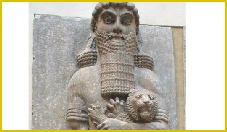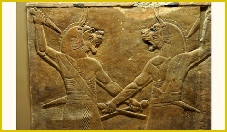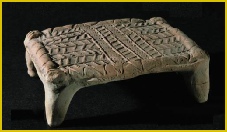












Last Gasps
Paranormal



The South’s science-based team!
Our trained investigators are here to believe you. Most importantly, we are here to solve the problem...no matter what it takes. Our services are always FREE.

© 2023 Last Gasps paranormal. Links | Terms and Conditions







Exorcisms: Catholic and Tibetan


Disclaimer: This work has been completed as an educational tool for students of history, religious and paranormal studies. The author wishes to discourage any use of this work in conjunction with paranormal field investigations of demons.
Presented by Kyle T. Cobb, Jr. to the audience of Dragon-Con 2014
Nos tibi credere.
A Literary History
Introduction
Demons… Just the word summons up of flood of images. Virtually every culture on earth has a form of demon as an integral part of its mythology.
From
the Oni of Japan
to the Utukku of the Gilgamesh saga
to Shedim of Israel
to Linda Blair in the Exorcist
to Anneliese Michel in Germany
to Gary, Indiana,
the concepts of demons excites us and cause some degree of uneasiness.
Today we are going to play academic. We are briefly going to look at two vastly different approaches to understanding demons. We are also going to look Exorcisms rituals used to banish them.
We began with a reading from
Acts 19:13-16
Aramaic Bible in Plain English
But there were also some Jewish men who were going around and were exorcists of demons, exorcising in the name of our Lord Yeshua over those who had a foul spirit in them, while saying, “We exorcise you in the name of Yeshua whom Paulus preaches.” But there were seven sons of a man who was a Jew, a Chief Priest, whose name was Sqewa, who were doing this, And that evil spirit answered and said to them, “I know Yeshua, and I know Paulus, but who are you?” And that man who had the evil spirit in him jumped upon them and overpowered them and threw them down, and when they were stripped and wounded, they fled from the house. And this became known to all the Jews and Aramaeans dwelling in Ephesaus and great fear fell upon all of them, and the name of our Lord Yeshua The Messiah was exalted. Many of those who believed were coming and relating their wrongdoing, and they were confessing the things that they were doing. Many sorcerers also gathered their books and brought and burned them before everyone and they calculated their price, and it came up to fifty thousand silver pieces.
One of the first issues a researcher will find in reading books on demonology is the tendency of many religious types to start out with a firm definition of what a demon is but then to digress into assigning mental and physical illness to demonic influences.
So, before we look at how we exorcise demons, it is important to set certain guidelines, or definitions. This will allow us to converse based on equalities and not assumptions.
Definition of a demon
The first problem we face is there is no universal definition.
So, how do we form a definition?
Gilgamesh
One of the oldest, most complete of the early stories is the epic of Gilgamesh. And this is where the first concrete references to demons reside. In the ancient Sumerian texts, there are three basic classes of demons:
Disembodied human spirits
Half-monster, half-human entities
Non-human forces
To the Summerians, demons such as the Utukku and Lamashtu haunted barren places and hunted man in dog-like forms with donkey teeth and ears. The Gallu was a bull spirit and the lilu were the Babylonian prototypes for the incubus/succubus legends. While many of these demons had physical components, it is also important to note that every physical and mental illness was attributed to some form of demon.
As a result, in Sumerian culture, a uniformed methodology evolved to deal with the demons. It became the tradition that the use of the demon’s name could bind it and force the demon from its host. If the specific name of the demon was unknown, then the recitation of a number of frequently encountered demons was performed believing that one of the names would apply.
It was through Sumerian exorcisms that the use of animal substitutes for the possessed individuals developed. The name of the demon was used to force it into its surrogates that would then be sacrificed. The exorcist would then invoke the name of the god Asari-alim-nunna to wash the victim. They would then physically wash the victim with water twice seven times.
The Sumerian exorcisms formed the basis of most western exorcism formulas that would follow.
Jewish Writings
In Jewish tradition, demons are treated more as non-corporeal beings. While early texts do have examples of physically embodied demons such as the Babylonian Shedim temple guardian, most Hebrew texts feature demons as spirits sent by God to issue punishments.
For example in Judges 9:23
Young's Literal Translation
and God sendeth an evil spirit between Abimelech and the masters of Shechem, and the masters of Shechem deal treacherously with Abimelech,
In the Hebrew we find the use of ר֣וּחַ (ru-ah) for spirit and evil רָעָ֖ה (ray-ayh). אֱלֹהִים֙ (ĕlōhîm) for God
We also find examples where the spirits sent by God are emotional states. This example is found in
1 Samuel 16:14
Young's Literal Translation
And the Spirit of Jehovah turned aside from Saul, and a spirit of sadness from Jehovah terrified him;
Like in the first example we see the spirit as רֽוּחַ־ (ru-ah) and evil רָעָ֖ה (ray-ayh). In this passage God is named as יְהוָֽה׃ (Yahweh).
New Testament
From a Christian perspective we continue to see the demons as non-corporeal.
This first New Testament reference in Matthew 4:24 sets the tone for the majority the encounters with demons.
Matthew 4:24
Aramaic Bible in Plain English
And his fame was heard in all Syria, and they brought to him all those who had become ill with various diseases, those who were afflicted with severe pain, and the demon possessed, and lunatics and paralytics, and he healed them.
For the most part demonic influence is treated like any other common illness.
In addition to being like an illness, the New Testament also gives the demons voice.
While there are many examples of Jesus casing out demons, Mark 1:23-27 provides a simple version of removing a demon.
Mark 1:23-27
Aramaic Bible in Plain English
And in their synagogue there was a man who had a vile spirit in him, and he cried out And he said, “What business do we have with you, Yeshua the Nazarene? Have you come to destroy us? I know who you are, The Holy One of God.” And Yeshua rebuked him and said, “Shut your mouth and come out of him.” And the foul spirit threw him down and he cried out in a loud voice and came out of him. And all of them marveled and they were inquiring with one another, saying, “What is this?”, and “What is this new teaching? For he commands even the foul spirits with authority and they obey him.”


Father Gabriele Amorth, former head of the Catholic Office of Exorcism and author of An Exorcist Tells His Story.


An image of Gilgamesh presently located in the Louvre.



Utukku

In Sumerian exorcism, the victim remains in bed with white string and a black string on each opposing side.



Shedim
| Paranormal Books |
| Apparitions |
| Cryptids |
| Demons |
| Orbs |
| Poltergiest |
| Residual Hauntings |
| Shadow People |
| West Demons |
| Ouija and Zozo |
| Exorcisms |
| Anneliese Michel |
| Ronald Hunkeler |
| Anna Ecklund |
| LaToya Ammons |
| George Lukins |
| Christian Demon texts |
| Roman Rite 1614 |
| Roman Rite 1998 |
| Eastern Demons |
| FAQ |